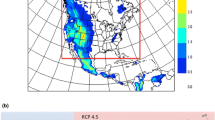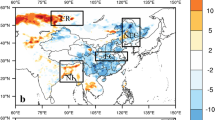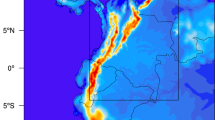Abstract
Changes in the essential climate extremes indices and surface variables for the end of the twenty-first century are assessed in this study based on two transient climate change simulations, with and without land-use and land-cover changes (LULCC), but identical atmospheric forcing. The two simulations are performed with the 5th generation of the Canadian Regional Climate Model (CRCM5) driven by the Canadian Earth System Model for the (2006–2100)-Representative Concentration Pathway 4.5 (RCP4.5) scenario. For the simulation with LULCC, land-cover data sets are taken from the global change assessment model (GCAM) representing the RCP4.5 scenario for the period 2006–2100. LULCC in RCP4.5 scenario suggest significant reduction in cultivated land (e.g. Canadian Prairies and Mississippi basin) due to afforestation. CRCM5 climate projections imply a general warming by the end of the twenty-first century, especially over the northern regions in winter. CRCM5 projects more warm spell-days per year over most areas of the continent, and implicitly more summer days and tropical nights at the expense of cold-spell, frost and ice days whose number is projected to decrease by up to 40% by the end of the twenty-first century with respect to the baseline period 1971–2000. Most land areas north of 45°N, in all seasons, as well as the southeastern United States in summer, exhibit increases in mean precipitation under the RCP4.5 scenario. In contrast, central parts of the continent in summer and much of Mexico in all seasons show reduced precipitation. In addition, large areas of North America exhibit changes of 10 to 40% (depending on the season and geographical location) in the number of heavy precipitation days. Results also suggest that the biogeophysical effects of LULCC on climate, assessed through differences between the two simulations, lead to warmer regional climates, especially in winter. The investigation of processes leading to this response shows high sensitivity of the results to changes in albedo as a response to LULCC. Overall, at the seasonal scale, results show that intense afforestation may contribute to an additional 25% of projected changes.















Similar content being viewed by others
References
Acosta-Navarro JC et al (2016) Future response of temperature and precipitation to reduced aerosol emissions as compared with increased greenhouse gas concentrations. J Clim. doi:10.1175/JCLI-D-16-0466.1 (in press)
Akhtar F et al (2009) Beyond the standards: designer air quality in 2050. Bull Am Meteorol Soc 89(1):38
Alexandru A Sushama L (2015) Impact of land-use and land-cover changes on CRCM5 climate projections over North America for the twenty-first century Clim Dyn 47(3):1197–1209
Arakawa A, Lamb VR (1977) Computational design of the basic dynamical process of the UCLA general circulation model. Meth Comput Phys 17:173–265
Arora VK, Boer GJ (2010) Uncertainties in the 20th century carbon budget associated with land use change. Glob Change Biol 16:3327–3348
Arora VK, Montenegro A (2011) Small temperature benefits provided by realistic afforestation efforts. Nat Geosci 4(8):514–518
Arora VK, Boer GJ, Christian JR, Curry CL, Denman KL, Zahariev K, Flato GM, Scinocca JF, Merryfield WJ, Lee WG (2009) The effect of terrestrial photosynthesis down-regulation on the 20th century carbon budget simulated with the CCCma earth system model. J Clim 22:6066–6088
Arora VK et al (2011) Carbon émission limits required to satisfy future representative pathways of greenhouse gases. Geophys Res Lett 38:L05805
Bala G, Caldeira K, Wickett M et al (2007) Combined climate and carbon-cycle effects of large-scale deforestation. Proc Natl Acad Sci USA 104(16):6550–6555
Bélair S, Mailhot J, Girard C, Vaillancourt P (2005) Boundary-layer and shallow cumulus clouds in a medium-range forecast of a large-scale weather system. Mon Weather Rev 133:1938–1960
Beltran-Przekurat A et al (2012) Modelling the effects of land-use/land-cover changes on the near-surface atmosphere in southern South America. Int J Climatol 32(8):1206–1225. doi:10.1002/joc.2346
Benoit R, Côté J, Mailhot J (1989) Inclusion of a TKE boundary layer parameterization in the Canadian regional finite-element model. Mon Weather Rev 117:1726–1750
Betts RA, Boucher O, Collins M, Cox PM, Falloon PD, Gedney N, Hemming DL, Huntingford C, Jones CD, Sexton, D.M.H., Webb MJ (2007) Projected increase in continental runoff due to plant responses to increasing carbon dioxide. Nature 448:1037–1041
Bonan GB (2008) Forests and climate change: forcings, feedbacks and the climate benefits of forests. Science 320:1444
Chen G-S et al (2011) Simulated local and remote biophysical effects of afforestation over the Southeast United States in Boreal summer. J Clim 25:4511–4522
Christian JR, Arora VK, Boer GJ, Curry CL, Zahariev K, Denman KL, Flato GM, Lee WG, Merryfield WJ, Roulet NT, Scinocca JF (2010) The global carbon cycle in the Canadian Earth System Model (CanESM1): preindustrial control simulation. J Geophys Res 115:G03014
Clarke L, Edmonds J, Jacoby H, Pitcher H, Reilly J, Richels R (2007a) CCSP synthesis and assessment product 2.1, part A: scenarios of greenhouse gas emissions and atmospheric concentrations. U.S. Government Printing Office, Washington DC
Clarke L, Lurz J, Wise M, Edmonds J, Kim S, Smith S, Pitcher H (2007b) Model documentation for the MiniCAM climate change science program stabilization scenarios: CCSP product 2.1a. PNNL technical report. PNNL-16735
Côté J, Gravel S, Méthot A, Patoine A, Roch M, Staniforth A (1998) The operational CMC-MRB global environmental multiscale (GEM) model. Part I: design considerations and formulation. Mon Weather Rev 126:1373–1395
Davies HC (1976) A lateral boundary formulation for multi-level prediction models. Q J R Meteorol Soc 102:405–418
Davin EL, de Noblet-Ducoudre N (2010) Climatic impact of global scale deforestation: radiative versus nonradiative processes. J Clim 23(1):97–112
Delage Y (1997) Parameterising sub-grid scale vertical transport in atmospheric models under statically stable conditions. Bound-Layer Meteorol 82:23–48
Delage Y, Girard C (1992) Stability functions correct at the free convection limit and consistent for both the surface and Ekman layers. Bound-Layer Meteorol 58:19–31
Diffeenbaugh NS, Scherer M, Ashfaq M (2012) Response of snow-dependent hydrologic extremes to continued global warming. Nat Clim Change 3(11): 379–384
Ellis PD (2010) The essential guide to effect sizes: statistical power, meta-analysis, and the interpretation of research results. Cambridge University Press, Cambridge (ISBN 978-0-521-14246-5)
Feddema J et al (2005) The importance of land-cover change in simulating future climates. Science 310(5754):1674–1678
Frich P et al (2002) Observed coherent changes in climatic extremes during the second half of the twentieth century. Clim Res 19:193–212
Gent PR, Bryan FO, Danabasoglu G, Doney SC, Holland WR, Large WG, McWilliams JC (1998) The NCAR climate system model global ocean component. J Clim 11:1287–1306
Hale RC, Gallo KP, Loveland TR (2008) Influences of specific land use/land cover conversions on climatological normals of near-surface temperature. J Geophys Res 113:D14113. doi:10.1029/2007JD009548
Harris I, Jones PD, Osborn TJ, Lister DH (2014) Updated high-resolution grids of monthly climatic observations-the CRU TS3.10 Dataset. Int J Climatol 34:623–642. doi:10.1002/joc.3711
Hartung J, Knapp G, Sinha BK (2008). Statistical meta-analysis with applications. Wiley, New York (ISBN 978-1-118-21096-3)
Huffman GJ, Adler RF, Bolvin DT, Gu G (2009) Improving the global precipitation record: GPCP version 2.1. Geophys Res Lett 36:L17808. doi:10.1029/2009GL040000
IPCC (2007a) Climate change 2007 IPCC fourth assessment report: synthesis report. IPCC, Geneva, pp 184–498
IPCC (2007b) Climate change 2007: the physical science basis. In: Contribution of working group I to the fourth assessment report of the intergovernmental panel on climate change. Cambridge University Press, Cambridge, p 996
IPCC AR5 (2012) Managing the risks of extreme events and disasters to advance climate change adaptation. In: A special report of working groups I and II of the Intergovernmental Panel on Climate Change. Cambridge University Press, Cambridge, p 582
Jihee S et al (2008) The impacts of urbanization on emissions and air quality: comparison of four visions of Austin, Texas. Environ Sci Technol 42(19):7294–7300
Kain S, Fritsch JM (1990) A one-dimensional entraining/detraining plume model and its application in convective parameterization. J Atmos Sci 47:2784–2802
Krinner G et al (2005) A dynamic global vegetation model for studies of the coupled atmosphere–biosphere system. Glob Biogeochem Cycles. doi:10.1029/2003GB002199
Kuo HL (1965) On formation and intensification of tropical cyclones through latent heat release by cumulus convection. J Atmos Sci 22:40–63
Kyle GP, Luckow P, Calvin KV, Emanuel WR, Nathan M, Zhou Y (2011) GCAM 3.0 agriculture and land use: data sources and methods. PNNL-21025. Pacific Northwest National Laboratory, Richland
Laguë M, Swann A (2016) Progressive mid-latitude afforestation: impacts on clouds, global energy transport, and precipitation. J Clim. doi:10.1175/JCLI-D-15-0748.1
Langlois A, Bergeron J, Brown R, Royer A, Harvey R, Roy A, Wang L, Thériault N (2014) Evaluation of CLASS 2.7 and 3.5 simulations of snow properties from the canadian regional climate model (CRCM4) over Québec, Canada. J Hydrometeorol 15:1325–1343. doi:10.1175/JHM-D-13-055.1
Laprise R (1992) The Euler equation of motion with hydrostatic pressure as independent coordinate. Mon Weather Rev 120:197–207
Laprise R, Hernández-Díaz L, Tete K et al (2013) Climate projections over CORDEX Africa domain using the fifth-generation Canadian Regional Climate Model (CRCM5). Clim Dyn 41:3219. doi:10.1007/s00382-012-1651-2
Lee X et al (2011) Observed increase in local cooling effect of deforestation at higher latitudes. Nature 479(7373):384–387
Legates DR, Willmott CJ (1990) Mean seasonal and spatial variability in gauge-corrected, global precipitation. Int J Climatol 10:111–127
Li J, Barker HW (2005) A radiation algorigthm with correlated-k distribution. Part I: Local thermal equilibrium. J Atmos Sci 62:286–309
Li D, Tian Y, Liu C, Hao F (2004) Impact of land-cover and climate changes on runoff of the source regions of the Yellow River. J Geog Sci 14:330–338
Li H, Zhang Y, Vaze J, Wang B. (2012) Separating effects of vegetation change and climate variability using hydrological modelling and sensitivity-based approaches. J Hydrol 420–421:403–418
Li Y et al (2015) Local cooling and warming effects of forest based on satellite observations. Nat Commun 6:6603. doi:10.1038/ncomms7603
Liu Y, Stanturf J, Lu H (2008) Modeling the potential of the Northern China Forest shelterbelt in improving hydroclimate conditions. J Am Water Res Assoc (JAWRA) 44(5):1176–1192. doi:10.1111/j.1752-1688.2008.00240.x
López-Moreno JI, Zabalza J, Vicente-Serrano SM, Revuelto J, Gilaberte M, Azorin-Molina C, Morán-Tejeda E, García-Ruiz JM, Tague C (2014) Impact of climate and land use change on water availability and reservoir management: scenarios in the Upper Aragón River, Spanish Pyrenees. Sci Total Environ 493:1222–1231
Mahmood et al (2010) Impacts of land use /land cover change on climate and future research priorities. Bull Am Meteorol Soc 91(1):37–46
Maloney ED et al (2014) North American climate in CMIP5 experiments: part III: assessment of 21st century projections. J Clim 27:2230–2270
McFarlane NA (1987) The effect of orographically excited gravity wave drag on the circulation of the lower stratosphere and troposphere. J Atmos Sci 44:1175–1800
Meinshausen M, Smith S (2011) The RCP greenhouse gas concentrations and their extension from 1765 to 2500. Clim Change (Special Issue on RCPs)
Moss R et al (2008) Towards new scenarios for analysis of emissions, climate change, impacts, and response strategies. Intergovernmental Panel on Climate Change, Geneva, p 132
Moss R et al (2010) The next generation of scenarios for climate change research and assessment. Nature 463:747–756
Pausata FSR et al (2016) Impacts of dust reduction on the northward expansion of the African monsoon during the Green Sahara period, Earth and plan. Sci Lett 434:298–307
Peacock S (2012) Projected twenty-first-century changes in temperature, precipitation, and snow cover over North America in CCSM4. J Clim 25(13):4405–4429. doi:10.1175/JCLI-D-11-00214.1
Peng SS et al (2014) Afforestation in China cools local land surface temperature. PNA 111(8):2915–2919
Pielke RA et al (2011) Land use/land cover changes and climate: modelling analysis and observational evidence, WIREs. Clim Change 2:828–850
Randerson JT et al (2006) The impact of Boreal forest fire on climate warming. Science 314(5802):1130–1132. doi:10.1126/science.1132075
Runnalls KE, Oke TR (2006) A technique to detect microclimatic inhomogeneities in historical records of screen-level air temperature. J Clim 19:959–978
Scinocca JF, McFarlane NA, Lazare M, Li J, Plummer D (2008) Technical note: the CCCma third generation AGCM and its extension into the middle atmosphere. Atmos Chem Phys 8:7055–7074
Seager R, Vecchi GA (2010) Greenhouse warming and the 21st Century hydroclimate of southwestern North America. Proc Natl Acad Sci 107(50):21277–21282. doi:10.1073/pnas.0910856107
Seidel DJ et al (2008) Widening of the tropical belt in a changing climate. Nature Geosci 1:21–24. doi:10.1038/ngeo.2007.38
Šeparović L, Alexandru A, Laprise R, Martynov A, Sushama L, Winger K, Tete K, Valin M (2013) Present climate and climate change over North America as simulated by the fifth-generation Canadian regional climate model. Clim Dyn. doi:10.1007/s00382-013-1737-5
Sillmann J, Kharin VV, Zhang X, Zwiers FW, Bronaugh D (2013) Climate extremes indices in the CMIP5 multimodel ensemble: part 1. Model evaluation in the present climate. J Geophys Res 118:1716–1733. doi:10.1002/jgrd.50203
Sitch S et al (2004) Evaluation of ecosystem dynamics, plant geography and terrestrial carbon cycling in the LPJ dynamic global vegetation model. Glob Change Biol 9(2):161–185
Smith SJ, Wigley TML (2006) Multi-gas forcing stabilization with the MiniCAM. Energy J (Special Issue #3):373–391
Stull RB (1988) An introduction to boundary layer meteorology. Kluwer Academic Publishers, London
Sundqvist H, Berge E, Kristjansson JE (1989) Condensation and cloud parameterization studies with a mesoscale numerical weather prediction model. Mon Weather Rev 117:1641–1657
Swann ALS, Fungc IY, Chiang JCH (2012) Mid-latitude afforestation shifts general circulation and tropical precipitation. Proc Natl Acad Sci 109(3):712–716
Swann ALS, Fungc IY, Liu Y, Chiang JCH (2014) Remote vegetation feedbacks and the mid-holocene green sahara. J Clim 27:4857–4870
Thomson AM, Calvin KV, Smith SJ, Kyle GP, Volke A, Patel P, Edmonds JA (2011) RCP4. 5: A pathway for stabilization of radiative forcing by 2100. Clim Change 109:77–94. doi:10.1007/s10584-011-0151-4
Trail M et al (2013) Potential impact of land use change on future regional climate in the Southeastern U.S.: reforestation and crop land conversion. J Geophys Res Atmos. doi:10.1002/2013JD020356
Verseghy D (2009) CLASS—the Canadian land surface scheme (version 3.4): technical documentation (Version 1.1)
von Salzen K, McFarlane NA, Lazare M (2005) The role of shallow convection in the water and energy cycles of the atmosphere. Clim Dyn 25:671–688
Wang SF, Kang SZ, Zhang L, Li FS (2008) Modelling hydrological response to different land-use and climate change scenarios in the Zamu River basin of northwest China. Hydrol Process 22:2502–2510
Willmott CJ, Matsuura K (1995) Smart interpolation of annually averaged air temperature in the United States. J App Meteorol 34:2577–2586
Wise MA, Calvin KV, Thomson AM, Clarke LE, Bond-Lamberty B, Sands RD, Smith SJ, Janetos AC, Edmonds JA (2009) Implications of limiting CO2 concentrations for land use and energy. Science 324:1183–1186
Woldemichael AT, Hossain FRA, Pielke S, Beltra ́n-Przekurat A (2012) Understanding the impact of dam-triggered land-use/land-cover change on the modification of extreme precipitation. Water Resour Res 48:W09547. doi:10.1029/2011WR011684
Yeh K-S, Côté J, Gravel S, Méthot A, Patoine A, Roch M, Staniforth A (2002) The CMC-MRB global environmental multiscale (GEM) model. Part III: nonhydrostatic formulation. Mon Weather Rev 130:339–356
Zadra A, Roch M, Laroche S, Charron M (2003) The subgrid- scale orographic blocking parametrization of the GEM Model. Atmos Ocean 41:155–170
Zadra A, Caya D, Côte J, Dugas B, Jones C, Laprise R, Winger K, Caron L-P (2008) The next Canadian regional c1imate model. Phys Canada 64:74–83
Zadra A, McTaggart-Cowan R, Roch M (2012) Recent changes to the orographic blocking. Seminar presentation, RPN, Dorval, Canada, 30 March 2012. 30/Seminar_2012-03-30_Ayrton-Zadra.pdf
Zhao Q et al (2015) Satellite-indicated long-term vegetation changes and their drivers on the Mongolian Plateau. Landscape Ecol 30(9):1599–1611
Acknowledgements
The computations were made on the Guillimin high-performance computing platforms, through the CLUMEQ Consortium, which is part of Compute Canada and a member of Calcul Québec.
Author information
Authors and Affiliations
Corresponding author
Rights and permissions
About this article
Cite this article
Alexandru, A. Consideration of land-use and land-cover changes in the projection of climate extremes over North America by the end of the twenty-first century. Clim Dyn 50, 1949–1973 (2018). https://doi.org/10.1007/s00382-017-3730-x
Received:
Accepted:
Published:
Issue Date:
DOI: https://doi.org/10.1007/s00382-017-3730-x




